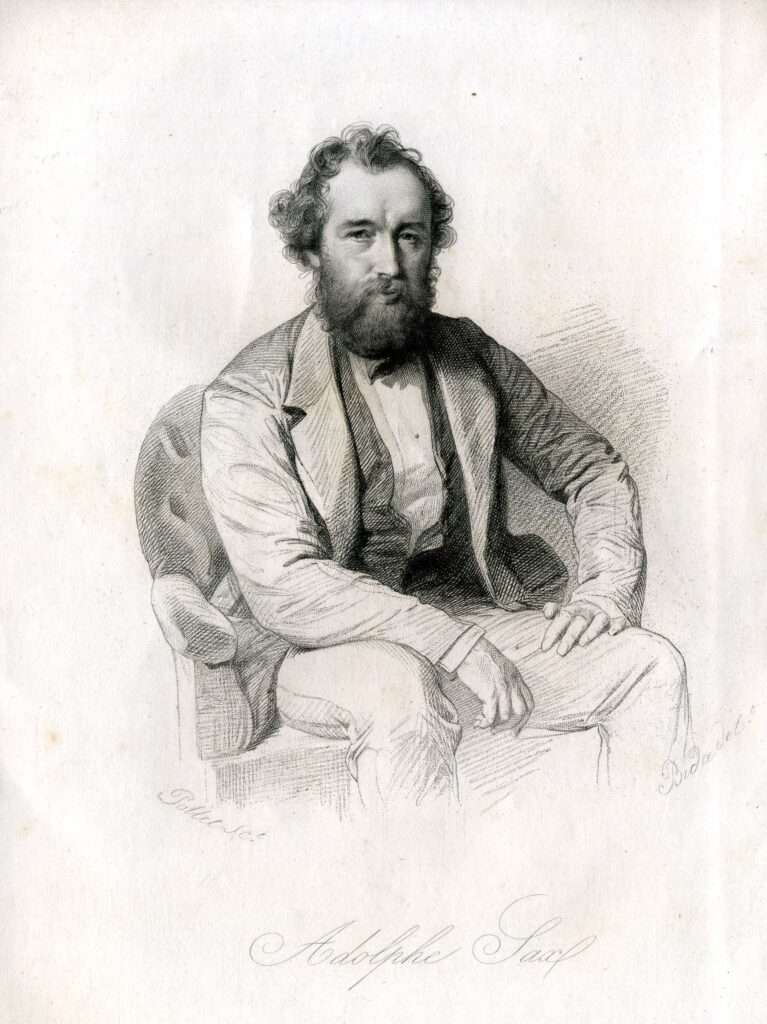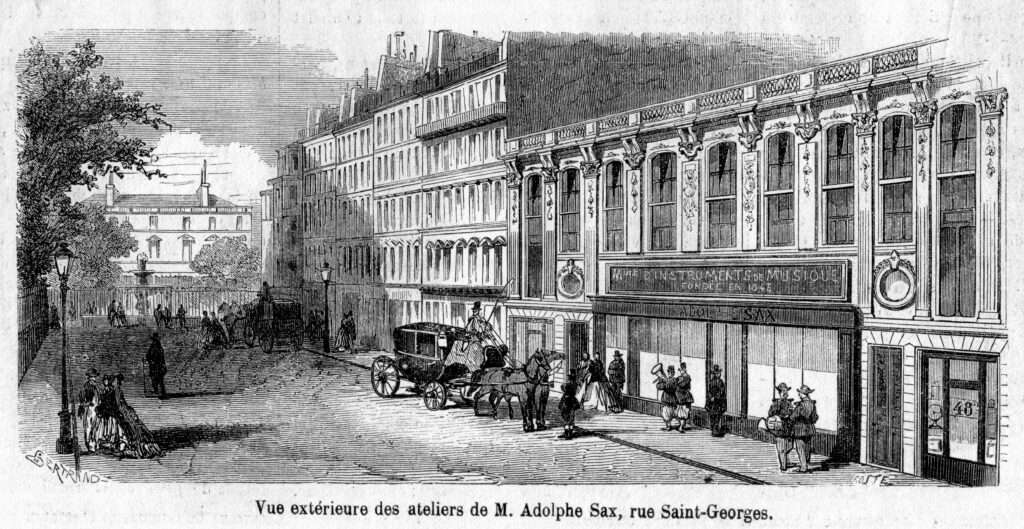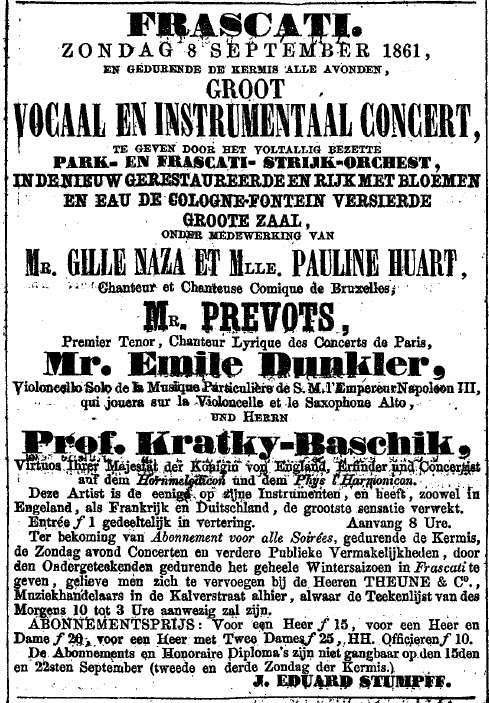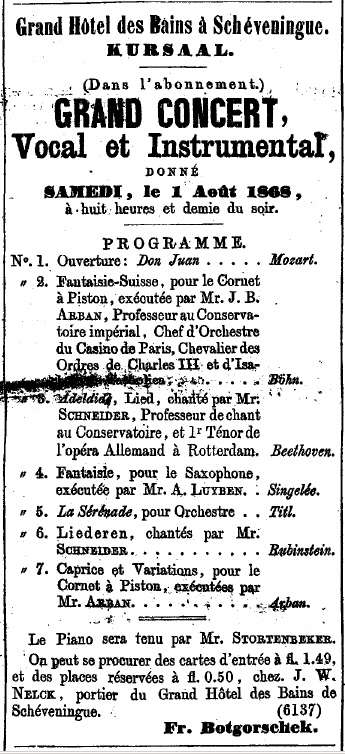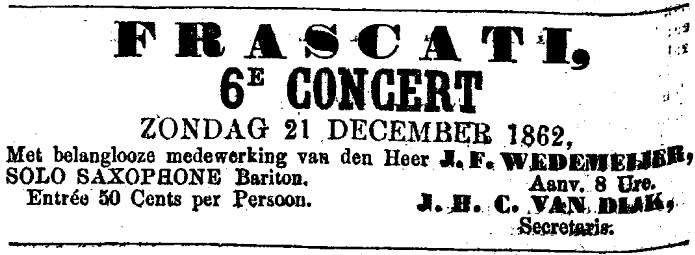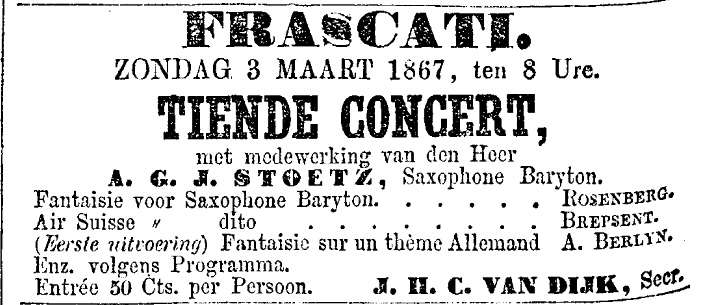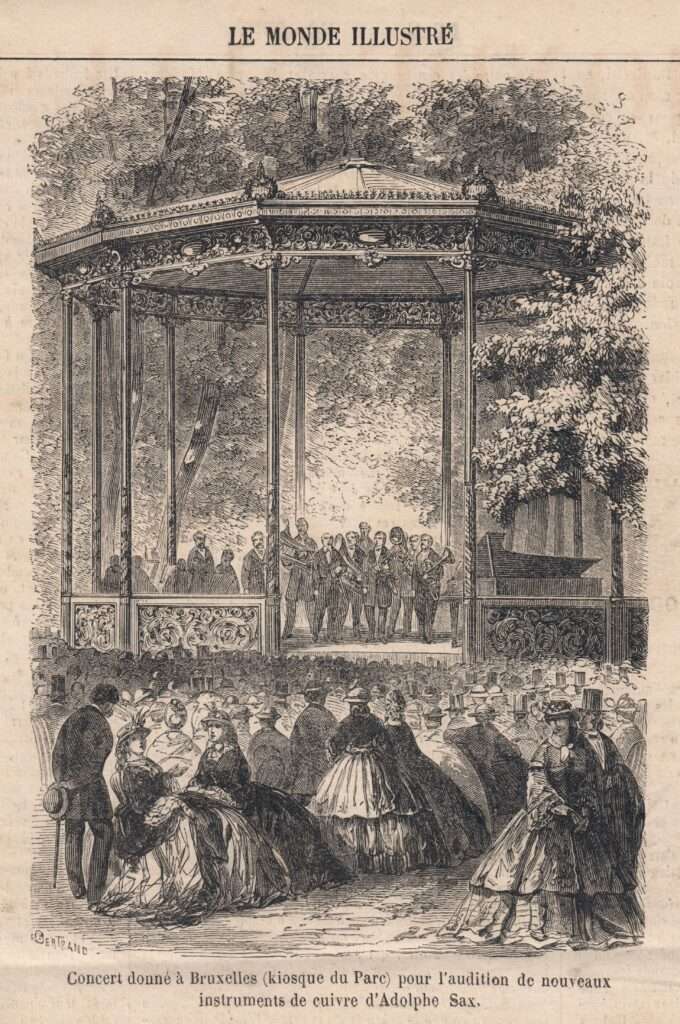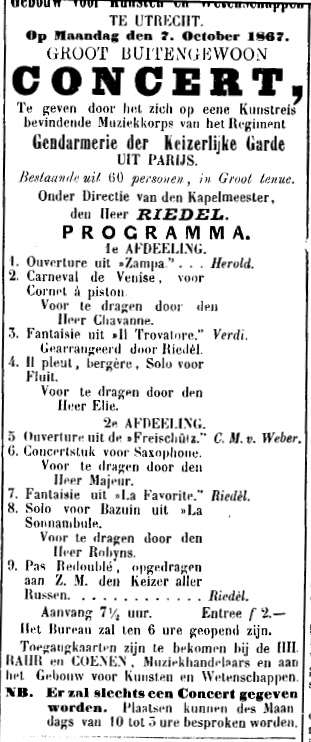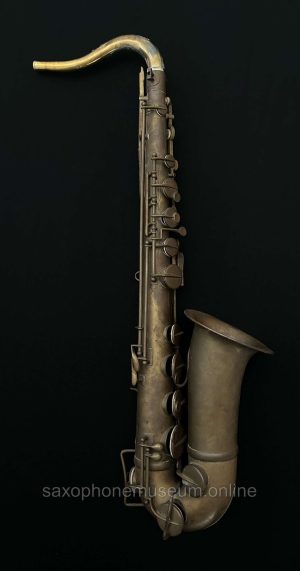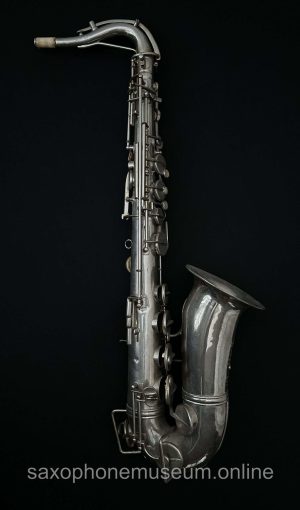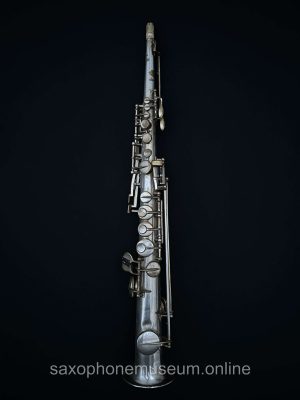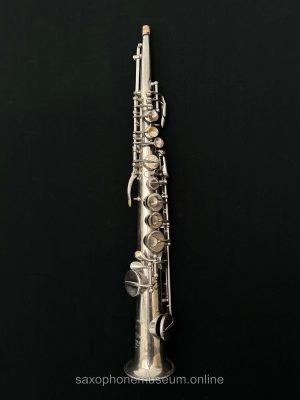When I assumed the role of Classical Saxophone Professor at the Fontys Conservatory in Tilburg, I started teaching lessons on “instrument knowledge.” These lessons encompassed various topics, including the construction and historical background of the saxophone. I thought a local history was a logical part to include, but my desire to delve into the history of this instrument in the Netherlands was met with a surprising lack of available information. So in 2006, I embarked on a journey of research and documentation, eventually leading to the publication of a book in 2013.
This page offers a condensed and translated excerpt from the chapter dedicated to the introduction of the classical saxophone in the Netherlands.
Table of Contents
Adolphe Sax (1814 – 1894)
Before delving into the introduction of the saxophone in the Netherlands, it’s important to have an impression of the instrument’s inventor, Adolphe Sax. There are excellent works available for that purpose, but I will give a brief overview here. For those interested in learning more about Adolphe Sax, I warmly recommend studying Malou Haine’s book, “Adolphe Sax, sa vie, son œuvre, ses instruments de musique” (Editions de l’Université de Bruxelles, 1980). Frederick Hemke’s dissertation, “The Early History of the Saxophone” (University of Wisconsin, 1975), is also a comprehensive work that includes numerous sources. However, for a concise overview, it may be less suitable due to its extensive nature.
Early life
Antoine-Joseph Sax, commonly known as Adolphe, was born on November 6, 1814, in Dinant, Belgium. His father, Charles-Joseph, was a musical instrument maker, and Adolphe was raised in an environment surrounded by musical instruments. In 1815, Charles-Joseph Sax established his company in Brussels. Adolphe showed an early aptitude for working on instruments, and before departing for Paris in 1842, he already had six patents registered in his name. The first saxophone was presented at an exhibition in Brussels in 1841. Due to Adolphe Sax’s youth, he was not awarded the coveted gold medal for his invention at that time but received a lesser “Médaille de Vermeil.”
Paris
In June 1842, Adolphe Sax left for Paris to explore the possibilities of establishing himself there. In the capital, he met notable figures, including Hector Berlioz, who wrote a report on Sax’s new instrument, the saxophone, in the newspaper “Journal des Débats” on June 12, 1842. Adolphe Sax permanently settled in Paris in October of that year, marking the beginning of a new chapter in his life—a turbulent existence characterized by rapid alternations between successes and setbacks. His competitors spared no effort in opposing him, leading to intrigues, trials, and even an assassination attempt. Financial troubles plagued Sax, largely due to a series of lawsuits initiated by his competitors, which ultimately led to several bankruptcies. He passed away in poverty.
In 1846, he patented the saxophone. But Adolphe Sax’s contributions extended beyond inventing the saxophone; he made improvements to numerous instruments, including the clarinet and the so-called saxhorns. He also pursued ambitious projects, such as designing a colossal organ and even a cannon.
There remains some uncertainty regarding the exact date of Adolphe Sax’s death. Various sources, such as “De Saxophone” by E. Elsenaar, cite February 4 as his date of death, while Haine and others mention February 7th, 1894. The bronze plaque on Sax’s tomb at the Montmartre cemetery in Paris also states February 7th, 1894 as the date of his passing.
There are many reports in Dutch newspapers about the death of Adolphe Sax in 1894. Despite the fact that he died poor, he had acquired a considerable name for himself, at least in the Netherlands.
Earliest introduction of the saxophone in the Netherlands
The ‘Algemeen Handelsblad’ of September 6th 1842 reports:
Eergisteren is den Heer Adolphe Sax, van Brussel, uitvinder van de Clarinette Cusse [sic] en van den zoogenaamden saxophon, instrumenten, die de bewondering van al de beroemde toonkunstenaren van het tegenwoordige tijdvak hebben uitgemaakt, de eer ten deel mogen vallen, zich bij den Koning te doen hooren, die hem tot dat einde in een bijzonder gehoor had toegelaten.
Het heeft Z.M. behaagd, den jeugdigen kunstenaar Hoogstdeszelfs tevredenheid en bijzondere belangstelling te betuigen over eene uitvinding, welke bestemd is, eenen zoo grooten invloed uit te oefenen op de vorderingen van het instrumentale onzer orkesten.
Translation
The day before yesterday, Mr Adolphe Sax, of Brussels, inventor of the Clarinette Cusse [sic] and of the so-called saxophon [sic], instruments, which have seen the admiration of all the famous composers of the present era, was bestowed the honour to be heard by the King, who had allowed him a special hearing to that end.
It has pleased H.R.H. to personally express satisfaction and special interest to the youthful artist about an invention, which is destined to exert great influence on the progress of our instrumental orchestras.
It is certainly not inconceivable that ‘an invention’ refers to the saxophone, and that Adolphe Sax thus presented the saxophone in the Netherlands as early as 1842. At that time, the King of the Netherlands was King Willem II. The fact that Charles-Joseph Sax had held the title of “purveyor to the court” since 1818 (as mentioned in Haine, 1980, page 30) may have played a role in arranging this presentation. Beginning in 1819, Charles-Joseph Sax supplied nearly all the instruments to the newly established Belgian military orchestras.
Military orchestras
Sax and military orchestras
On March 1, 1845, Adolphe Sax submitted a proposal to the French government to reorganize military orchestras.
Vooral zouden de technisch onvolmaakte instrumenten door betere vervangen moeten worden, waardoor op het aantal musici bezuinigd zou kunnen worden. Het nieuwe orkest verschilde in zoverre van het oude, dat Sax het getal der clarinetten (14 bij het oude militaire orkest) tot 6 verminderde, de hobo’s, fagotten en hoorns verwijderde en daarvoor een gedeeltelijk viervoudig bezette saxhoorn- resp. saxophonefamilie invoerde. (Elsenaar, 1947, 21)
Translation
In particular, the technically imperfect instruments should be replaced by better ones, which could reduce the number of musicians. The new orchestra differed from the old one in that Sax reduced the number of clarinets (14 for the old military orchestra) to 6, removed the oboes, bassoons and horns and instead introduced a family of partly fourfold saxhorns and saxophones.
After a public competition between two orchestras in old and new line-up on the Paris marching field (where the Eiffel Tower is now located) on April 22nd 1845, the reorganisation of the orchestration proposed by Sax became final on September 10th 1845, 11. From that moment on the saxophone has been part of the standard instrumentation in France. Sax also received the Knight’s Cross of the Order of the Oak Crown at that time.
In the Netherlands: Dunkler Sr. & Jr.
The further introduction of the saxophone in the Netherlands is closely tied to the Dunkler name, as well as to Dutch military music.
In 1829, the Grenadiers Music Corps (muziekkorps der Grenadiers) was established in the Netherlands, with François Dunkler Sr. (born in Rastatt, Germany in 1779 and passing away in the Hague, Netherlands in 1861) as its inaugural chief conductor. In 1843, a merger occurred between the Grenadiers Corps and the Hunters Corps (korps Jagers), resulting in the formation of a single official orchestra for the Dutch army, known as ‘The Grenadiers and Hunters‘ (Grenadiers en Jagers).
Dunkler Jr.
On April 11, 1849, François Dunkler Sr. was succeeded by his son, François Dunkler Jr. (born in Namur, Belgium in 1816 and passing away in the Hague, Netherlands in 1878). It was Dunkler Jr. who introduced saxophones into his orchestra. Unlike the present-day combination of alto, tenor, and baritone saxophones, Dunkler’s works, published by Adolphe Sax, included a full saxophone quartet, including a soprano saxophone.
In 1876, with the bestowment of the ‘Royal’ designation, the orchestra’s name changed to ‘Royal Military Band‘ (Koninklijke Militaire Kapel). In more recent history, in 2005, this orchestra merged with the ‘Johan Willem Friso Kapel,’ and the newly formed ensemble now performs under the name ‘Royal Military Band Johan Willem Friso’.
Dunkler and Sax
Elsenaar adds the following footnote to his text:
Wij vermoeden, dat deze onderscheiding door Koning Willem III is verleend op voorspraak van Fr. Dunkler Sr., dirigent van het muziekkorps der Grenadiers en Jagers, die, evenals zijn zoon en opvolger, onze vermaarde Dunkler, een groot vereerder was van Sax’ uitvindingen; beiden voerden deze bij hun korps in. (Elsenaar, 1947, 25-26)
Translation
We suspect that this decoration was granted by King Willem III on the intercession of Fr. Dunkler Sr., conductor of the band of Grenadiers and Hunters, who, like his son and successor, our renowned Dunkler, was a great admirer of Sax’ inventions; both introduced these to their band.
From an article in ‘Dagblad voor Zuidholland en ‘s Gravenhage’, it appears that there was personal contact between Dunkler and Sax. This article reports on a visit by Dunkler to Paris to study new inventions of Sax. Since Dunkler is received with all military honours in the country, this is probably Dunkler Jr., who at that time was conductor of the Grenadiers and Hunters.
Emile Dunkler
The connection of the Dunkler family and the saxophone extends to another generation: the son of François Dunkler Jr., Emile Dunkler, appears to have been an accomplished saxophone player in his own right. Several concert announcements show him performing a solo work for saxophone, and a review in ‘Nieuw Amsterdamsch Handels- en Effectenblad’ of September 23rd 1861 underlines this: “Mr. Dunkler, solo cellist of Napoleon III and first saxophone of the imperial guides, deserves ample praise.”
The two Kinsbergens
One year before the expiration of Adolphe Sax’s initial saxophone patent in 1866, an intriguing event unfolded. It marked the emergence of a saxophonist named Kinsbergen, with the first public announcement of their concert.
In my research, I uncovered a fascinating trove of 82 articles in Dutch newspapers spanning the period from 1860 to 1900, all referencing individuals named ‘Kinsbergen.’ However, it quickly became apparent that these were two distinct people: Leon Kinsbergen Mzn. & Jacques Salomon Kinsbergen.
The fact that two musicians with almost the same name are so important to the early history of the saxophone is confusing and fascinating at the same time. As we delve into the information extracted from numerous newspaper articles, we gain a vivid insight into the pioneering utilization of the saxophone in the Netherlands by these two distinct individuals.
Leon Kinsbergen Mzn.
gained regular mention in newspapers starting from 1860. Born in Amsterdam, he was 22 years old at the time. Kinsbergen’s performances in Amsterdam primarily took place at ‘Frascati’ and ‘Parklocaal.’ Additionally, he achieved success on international stages. He frequently participated in charitable concerts, supporting causes like flood victims and the ‘diamond workers orphans fund.’ Although he was proficient in playing the clarinet and the violin, Kinsbergen established his reputation primarily as a saxophonist. Reviews of his saxophone performances consistently praised his skill.
The Park Orchestra
In addition to his solo endeavors, Leon Kinsbergen contributed his talents to the park orchestra (parkorkest), which was founded in 1849 by Eduard Stumpff. His repertoire featured transcriptions of operatic melodies and symphonic pieces, with regular renditions of works like the ‘Grande Fantaisie pour Saxophone Alto sur des motifs de l’Opéra Robert le Diable.’
Notably, an announcement for a Stumpff orchestra concert at Frascati highlighted a ‘Fantaisie for saxophone’ composed by E. Dunkler, with Kinsbergen as the soloist. This same event featured works by F. Dunkler (Sr. or Jr., though the exact identity is unclear).
Personal life
Leon Kinsbergen was officially listed as a ‘musician’ in the population register when he married Rachel Velleman in 1867. The couple, Leon Kinsbergen and Rachel, were parents to at least six children: Daatje, Mietje, Simon, Salomon, Mozes, and Manus. The names strongly indicate their Jewish heritage. Mozes Kinsbergen worked as a diamond cutter, shedding light on the potential connection between Leon Kinsbergen’s charitable performances and the ‘diamond workers orphan fund.’ Their son, Manus, first appeared in the population register as a ‘diamond cutter’ before later being registered as a ‘musician.’
Jacques Salomon Kinsbergen
From 1862 onwards, the name ‘Jacq. S. Kinsbergen’, starts appearing in newspapers. Various genealogical sources indicate that this person is Jacques Salomon Kinsbergen (born about 1839- deceased 1917), registered professions ‘music master‘ and ‘musician‘. From several reviews it can be gathered that he played both alto and soprano saxophone.
Jacques Kinsbergen collaborated as a soloist with several orchestras, including the music choir of the civic guard and a string orchestra led by Joh. Coenen. However, the majority of his concerts took place as a soloist with the Amsterdam Orchestra Association (Amsterdamse Orkest Vereniging), working under the direction of various conductors. The last documented appearance of Jacques Kinsbergen in a daily newspaper was on July 25th, 1900, in an announcement of a concert by the aforementioned Amsterdam Orchestra Association.
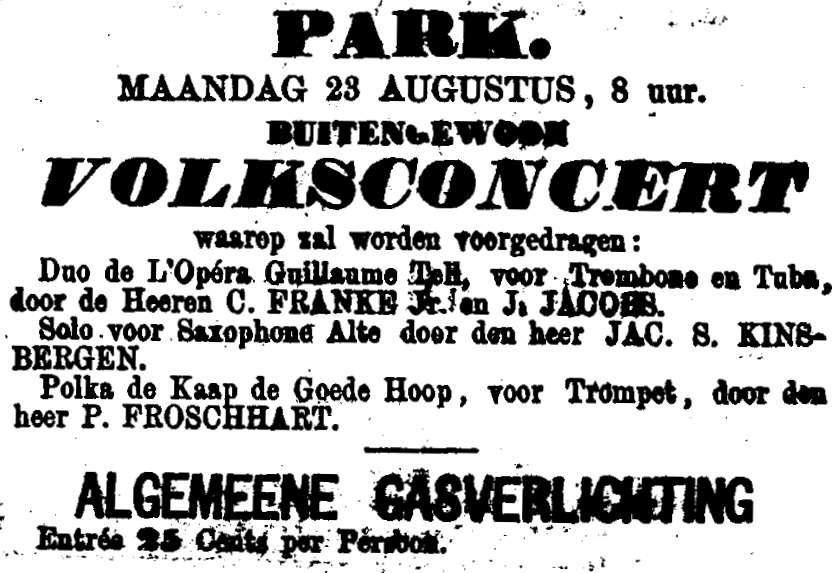
A review in ‘Nieuw Amsterdamsch Handels- en Effectenblad’ of Monday February 4th 1861, 33 provides important information about Kinsbergen and the status of the saxophone at that point in time:
Wij waren voor enigen tijd in de gelegenheid een nieuw muziekinstrument te leeren kennen, waarop wij des te gereeder de aandacht van het kunstminnend publiek vestigen, naardien een onzer stadgenoten en vaardige exécutanten, op het gebied der toonkunst, de heer L. Kingsbergen [sic] Mz. de eenige virtuoos op dit blaaswerktuig is. Wij bedoelen den saxophone Alto, waarop de heer Kingsbergen onlangs, bij gelegenheid eener in het Grand Théâtre des Variétés van den heer A. van Lier, ten voordeele der waternoodlijdenden gegeven voorstelling, op hoog verdienstelijke wijze eene fantaisie uit Robert le Diable heeft voorgedragen.
De bijzonderheden van dit instrument zijn de volle toonen en het bijzonder schoone, geheel eigenaardige geluid in zijn boven- en middenregister, een geluid, dat zich van de tot hier [t]oe bekende meer snijdende blaasinstrumenten door zijne zachte smeltende toonen gunstig onderscheidt. Van daar dat de saxophone in de handen van den bekwamen meester voor solo- of obligaatspel meer bijzonder geschikt is.
Translation
For some time, we have had the opportunity to get to know a new musical instrument, to which we draw the attention of the art-loving public all the more rightly. Our fellow townsmen and skilfull performer in the field of music, Mr. L. Kingsbergen [sic] Mz. is the only virtuoso on this wind instrument. We are referring to the alto saxophone, on which Mr Kingsbergen recently, at the benefit for the victims of the flood has recited a highly acclaimed fantasy from Robert le Diable in Mr A. van Lier’s Grand Théâtre des Variétés.
The particularities of this instrument are the full tones and the especially clean, completely unique sound in its upper and middle registers, a sound that distinguishes itself favourably from the more cutting wind instruments hitherto known by its soft melting tones. For this reason, the saxophone, in the hands of a skilled master, is more than suitable for solo performances.
In ‘Algemeen Handelsblad’ of March 9th 1865, 34 we find the following, very informative review:
Maandag 27 Febr. jl. had in het lokaal Frascati het vroeger geannonceerde concert plaats van de Heeren J. Jacobs en Jacq. Kinsbergen. Beide executanten handhaafden hun gevestigden goeden naam; de Heer Kinsbergen door de smaakvolle en zorgvuldige voordragt van het eerste concert voor viool van de Beriot en eene fantaisie van Pellegrin op il Trovatore […]
[…] terwijl de Heer Kinsbergen nog voordroeg eene romance voor saxophone-sopraan van W. Wijsman. Als violist toonde de Heer Kinsbergen groote vaardigheid en zekerheid en een vollen ronden toon te bezitten; zijne voordragt op de saxophone onderscheidde zich door zuiverheid en zangrijkheid, zoodat hij herhaalde malen onder luide toejuichingen werd teruggeroepen […]
Translation
Last Monday, Febr. 27th, the previously announced concert of the gentlemen J. Jacobs and Jacq. Kinsbergen took place in the Frascati room. Both performers maintained their established good name; Mr Kinsbergen by the tasteful and careful presentation of the first concerto for violin by de Beriot and a fantasy by Pellegrin on il Trovatore […].
[…] Mr. Kinsbergen furthermore performed a romance for soprano saxophone by W. Wijsman. As violinist Mr. Kinsbergen showed great skill and assurance, his tone full and round; his performance on the saxophone was marked by purity and melodiousness, for which he was repeatedly called back on stage by loud cheers […].
The mentioned Romance for soprano saxophone by Wijsman was performed by Jacques Kinsbergen at several concerts. This article shows that he also played the violin. That instrument probably formed his musical background.
With the exception to a single concert in Wijk aan Zee, Leon Kinsbergen primarily graced the stages of Amsterdam. His performances were held at various venues, including ‘Paleis voor Volksvlijt,’ ‘The Park,’ ‘Natura Artis Magistra,’ and ‘The Arena at Ruysdaelkade.’ His repertoire encompassed pieces like the Fantaisie Pastorale by Jean Baptiste Singelée, Fant[aisie] Don Pasquale by Verroust, Fantasie for alto saxophone by J. Presburg, Solo for saxophone by Verweert, Le Tribut de Zamora by Gounod, and La Somnambule by Bellini. Interestingly, compared to his namesake Leon Kinsbergen, Jacques seemed to increasingly draw from contemporary compositions rather than excerpts from operas and well-known (folk) melodies.
An article from February 8th, 1892, in ‘Het Nieuws van den Dag’ reports on a performance involving navy officers at their annual gala, in which Kinsbergen took part. This review provides insight into the prevailing sentiment that the saxophone was not yet fully embraced:
Dit alles werd afgewisseld, behalve door het Orkest, door voordrachten voor zang […] en eene solo voor saxophone, een voor soli weinig gebruikt en eigenlijk weinig bruikbaar instrument, dat intusschen door den Heer Kinsbergen niet onverdienstelijk bespeeld werd.
Translation
All this was alternated, except by the orchestra, vocal performances […] and a solo for saxophone, an instrument little used for solos and actually not very useful, which was played not without merit by Mr. Kinsbergen.
The Saxophonists of the Grenadiers and Hunters
Van der Linden & Luyben
From the 1860s onwards, saxophonists from the Grenadiers and Hunters were the main performers that show up in daily newspapers. W. van der Linden, and A. Luyben/Luijben are two names that are part of this musical narrative, though easily the most renowned saxophonist who has worked with the Grenadiers and Hunters is Eduard Lefèbre.
Van der Linden made his debut in 1866 at ‘Dagblad van Zuidholland en ‘s Gravenhage’ with a concert announcement at Diligentia, The Hague. The subsequent review from August 14, 1866, lauded his performance on the ‘heavy instrument’ – the saxophone – earning him well-deserved praise. In 1879, he earned a promotion to the position of second conductor of the Grenadiers and Hunters’ band. Further intrigue arises from a mention of ‘Ter Linden,’ another saxophonist, performing in New York, but whether it’s the same musician remains uncertain.
In 1868, A. Luyben first makes an appearance, participating in a notable concert that featured renowned trumpeter Arban, among others. The ‘Noordbrabanter’ of August 13, 1868, marveled at Luyben’s performance, highlighting his remarkable talent as a young artist who took the stage alongside celebrated musicians (see below).
Although this review promises greatness, the last mention of Luyben is an announcement for a concert at the ‘Odeon’ in Zwolle on December 13, 1869.
De heer Luijben, saxophonist bij het muziekkorps der Grenadiers, verleende jl. Zaterdag zijne medewerking aan een koncert door de heeren Arban, solo kornet à piston aan het keizerlijk konservatoire te Parijs en Schneider, eerste tenor aan de Hoogduitsche Opera te Rotterdam, in de kursaal van het Badhuis te Scheveningen gegeven.
Was ik onwillekeurig verbaasd, dat zulk een jeugdig kunstenaar als Luijben (die voor weinige jaren nog te Herpt, een klein dorpeke in Noordbrabant, de ploeg op den akker zijns vader stuurde) zich als solist durfde plaatsen naast twee zoo vermaarde en teregt gevierde kunstenaars als de heeren ARBAN en SCHNEIDER, die verbazing ging weldra over in verrassing en bewondering, toen de toonen van zijn fraai instrument door de koncertzaal ruischten. De afwisselende zachtheid en kracht van toon, de gevoelvolle en wegslepende voordragt en de bijna ongeloovelijke vlugheid deden Luijben een succes behalen, zoals welligt nimmer een kunstenaar te beurt viel, die, zoo als hij, onbekend en voor het eerst als solist optrad en dat naast talenten van zoo zeldzame gehalte als Arban en Schneider.
ARBAN en SCHNEIDER (het doet hun kunstenaarshart eere) waren zoo getroffen door het geniaal talent van hun jeugdigen kunstbroeder, dat zij hem omarmeden, toen hij onder daverend applaus het orchest verliet.
Ik vlei mij, dat Noordbrabant prijs zal stellen op dezen veel belovenden zoon en dat kunstminnaars zich zullen vereenigen, om, hetzij nu, hetzij later, hunne gewestgenooten in de gelegenheid te stellen, dezen waren kunstenaar ook in Noordbrabant te hooren.
Een bestendig lezer.
’s Hage 7 aug. 1868
Translation
Mr. Luijben, saxophonist with the Grenadiers’ band, provided his co-operation last Saturday in a concert by Mr. Arban, solo cornet player at the imperial conservatory in Paris and Mr. Schneider, first tenor at the High German Opera in Rotterdam, in the ‘kursaal’ of the ‘Badhuis’ in Scheveningen.
I was involuntarily surprised that such a young artist as Luijben (who a few years ago was still manning the plough in his father’s field in Herpt, a small village in North Brabant [province in the south of the Netherlands]) dared to place himself, as a soloist, next to two artists as famous and celebrated as the gentlemen ARBAN and SCHNEIDER. Amazement soon turned into surprise and admiration, when the tones of his beautiful instrument were resonating through the concert hall. The alternating softness and power of tone, the sensitive and lively recitation and the almost unbelievable speed made Luijben achieve success, as never was the case with an artist who, like him, performed as a soloist for the first time and who, besides talents of such rare quality as Arban and Schneider, was unknown.
ARBAN and SCHNEIDER (it does their artist’s heart credit) were so struck by the genius talent of their young brother in art that they embraced him when he left the orchestra with resounding applause.
I hope that North Brabant will appreciate this promising son and that art lovers will join forces, whether now or later, to give their fellow countrymen the opportunity to hear this artist in North Brabant as well.
An enthousiastic reader.
‘ s Hage Aug. 7th 1868
Eduard Abraham Lefèbre (1835-1911)
Eduard Lefèbre’s started playing the saxophone after meeting Adolphe Sax in Paris. A newspaper report from July 14th, 1858, highlights his early involvement as a musician in Dunkler’s orchestra of the Grenadiers and Hunters. This marked the beginning of a musical career that took him to South Africa, back to the Netherlands, and onto various stages across Europe and the United States, where he received accolades from esteemed composers and earned a reputation as ‘The Saxophone King.’
Eduard Lefèbre’s impact on the saxophone’s global development was substantial. Often referred to as ‘The Saxophone King,’ he achieved immense popularity due to his extraordinary instrument and remarkable technique. James Noyes even posited that Lefèbre formed a crucial link between Adolphe Sax’s innovations and the widespread acceptance of the saxophone in the 20th century.
Other saxophonists
- Wedemeijer: active at least between 1862 and 1863. Amsterdam area. Entries as baritone saxophonist only.
- A.G.J. Stoetz: active at least between 1864 and 1890. Amsterdam area. Also played the baritone saxophone.
- Agthoven: active at least in 1864. In that year he performed with the newly founded Paleisorkest. Amsterdam area.
- J.A. Presburg: active at least in 1888, his name also appears in the repertoire of saxophonist Jacq. Kinsbergen. Amsterdam area.
It is not inconceivable that these saxophonists were also members of one of the Dutch military orchestras.
On Wednesday, July 19th, 1899, the Utrecht City Orchestra conducted by W. van der Blij gave a concert in Natura Artis Magistra (nowadays known as the Artis Zoo). On this occasion, C. Ph. Klemann, J. Ph. Klemann and H.W. Bonnes played a trio for alto, tenor and baritone saxophone by C. Ph. Klemann. Perhaps these were relatives of Joop Klemann? The latter played cello in the Concertgebouw orchestra in Amsterdam in the 40’s and 50’s. He was also a meritorious saxophonist.
The saxophone in amateur associations
From 1864 onwards, more and more articles appear in which mention is made of concerts by amateur associations in which a saxophone is presented as solo instrument. Perhaps this is related to the fact that Adolphe Sax’s patent on the saxophone expired in 1866, and an acceleration in terms of fabrication of saxophones by Sax’ competitors followed.
Already in 1866, ‘De Locomotief, Samarangsch Handels en Advertentie-Blad’ shows an advertisement of ‘Muzyk-Vereeniging St. Cecilia’, who feature ‘Solos for Saxophone and Song’ in their program! In France, around 1867, the family of saxophones is not yet included in the standard instrumentation of civil music societies, but the instrument is ‘tolerated’.
![[Onbekend]/ZB Beeldbank Zeeland/1116.](https://saxophonemuseum.online/wp-content/uploads/2023/10/FO001116-1024x766.jpg)
Remarkable visitors
Louis-Adolphe Mayeur
Louis-Adolphe Mayeur (1837-1894) came from Menin, Belgium. He studied saxophone with Hyacinthe Klosé and Adolphe Sax in Paris. Mayeur was considered the best saxophonist of his time. He first played clarinet with the ‘Musique de l’Artillerie du Garde Impériale’ (a precursor of the Garde Republicaine orchestra). From 1871 onwards, he was a soloist at the opera of Paris, where he played the bass clarinet and saxophone. He wrote his method book for saxophone ‘Grande Méthode’ in 1867.
Belgium and the Netherlands, 1864
In 1864, a group of musicians toured the Netherlands and Belgium. During this trip they visited Antwerp, Brussels, Liège, Ostend, Amsterdam, Rotterdam and The Hague. This ensemble of 8 excellent musicians, led by Hernette, demonstrated the new instruments of Adolphe Sax during its concerts.
De omwenteling, die de nieuwe instrumenten van den heer Adolphe Sax sints [sic] geruimen tijd in de muziekwereld tot stand bragten, hebben de aandacht in hooge mate op zijn fabrikant gevestigd. Het zal thans voorzeker aan alle kunstvrienden en deskundigen aangenaam zijn van nabij met den aard, het vermogen en het klankgehalte van sommige dier instrumenten bekend te worden.
(Nieuwe Rotterdamsche Courant, 22 July 1864, 2)
Translation
The revolution that Mr Adolphe Sax’s new instruments have caused for quite some time in the music world, has drawn attention to the manufacturer to a great extent. It will now certainly be pleasant for all art lovers and experts to get to know the nature, ability and sound of some of these instruments up close.
Mayeur played several saxophones during these concerts. As soloist, he played “Fantaisie sur l ‘air de la Somnambule” by Bellini, in a transcription of Singelée on alto saxophone accompanied by piano.
Imperial Guard Corps, 1867
In October 1867, Mayeur found himself in the Netherlands again. He could be heard as a soloist at a concert of the Imperial Guard Corps, of which he was a member at that time.
At least the following concerts took place:
- Sunday October 6th, Musis Sacrum, Arnhem;
- Monday October 7th, arts and sciences building, Utrecht;
- Tuesday October 8th, Thursday October 10th Friday October 11th, Paleis voor Volksvlijt, Amsterdam.
This last concert was advertised for as follows ‘by popular demand: absolute last performance and farewell concert for the people’. Earlier, the concert of October 10th had already been announced as being the last one. Apparently the concerts were quite successful.
A review from Algemeen Handelsblad of October 10th 1867, 106 mentions:
Wanneer wij thans tot de solo-voordragten overgaan, dan hebben wij met veel lof te gewagen, zoowel van den Heer Chavanne, (cornet-à-piston) als van den Heer Elie (flauto piccolo) en van den Heer Majeur [sic] (saxophone). […] De saxophonist even als de trombonist de Heer Robyns bezitten eene breede, vrije voordragt, zijn met alle grepen hunner instrumenten volkomen vertrouwd en hebben zich te verheugen in de goedkeuring hunner hoorders.
Translation
Moving on to the solo performances, we have to praise Mr. Chavanne, (cornet-à-piston), Mr. Elie (piccolo) and Mr. Majeur [sic] (saxophone). […] The saxophonist as well as the trombonist Mr. Robyns possess a broad tone, free diction, and are perfectly familiar with the technique of their instrument,s and can rejoice in the approval of their listeners.
The Jullien Orchestra
In 1857, the renowned orchestra of Louis Antoine Jullien (1812-1860) made a visit to the Netherlands. Concerts took place in Rotterdam on May 5th and 7th. During concerts in England and the USA Jullien introduced a novel element by featuring two clarinetists as saxophone soloists for the first time. These two performers were Henry Wuille (1822-1871), originally from Antwerp, and the Frenchman Jean Baptiste Souallé (?-1888).
Wuille became a part of Jullien’s orchestra in 1852 and remained with the ensemble until 1856. After his tenure with Jullien, he settled in Strasbourg, where he took on a role teaching the clarinet at the conservatory. During this period, he frequently delivered saxophone recitals. Notably, the well-known piece ‘Fantaisie sur une thème originale’ by Jules Demersseman (1833-1866) was composed specifically for Wuille.
Souallé, better known as Ali-Ben-Sou-Alle or Aliben-Soualle, was part of Jullien’s orchestra, at least in 1850 and 1851. However, by 1857, it is likely that he had departed from the group, as he had started to travel the world as a soloist. During these solo performances, Sou-Alle showcased his talent on both the clarinet and saxophone, often dressed in Oriental attire. He referred to the saxophone as the “Turkophone,” and some reviews also mention “Turkophonini.” This name implies that he might have been playing a soprano or sopranino saxophone. However, there is no documented evidence of Soualle giving solo concerts in the Netherlands.
In addition to dance music, Jullien’s orchestra also included works by Beethoven and Mendelssohn in their repertoire. Unfortunately, Jullien’s life was cut short when he passed away after a brief stay in a sanatorium in 1860.
Learn more
The history of the Classical Saxophone in the Netherlands (book)
References*
Elsenaar, E. (1947). De Saxophone: Lispet, Hilversum.
Haine, M. (1980). Adolphe Sax: 1814-1894: sa vie, son oevre et ses instruments de musique: Editions de l’Université de Bruxelles.
Rorive, J-P. (2004). Adolphe Sax, Inventeur de genie: Racine.
Yperen, R. van (1966). De Nederlandse Militaire Muziek: Van Dishoeck, Bussom.
Vis, G. (2007). Gaudeamus: het Leven van Julius Rönten (1855-1932). Componist en musicus. [Thesis] Utrecht: Universiteit Utrecht.
Noyes, J. R. (2000). Edward A. Lefebre (1835*-19110: Preeminent saxophonist of the nineteenth century. [Thesis] Manhattan, USA.
* Full list of newspaper articles, websites and other literature available in my book or on request.

